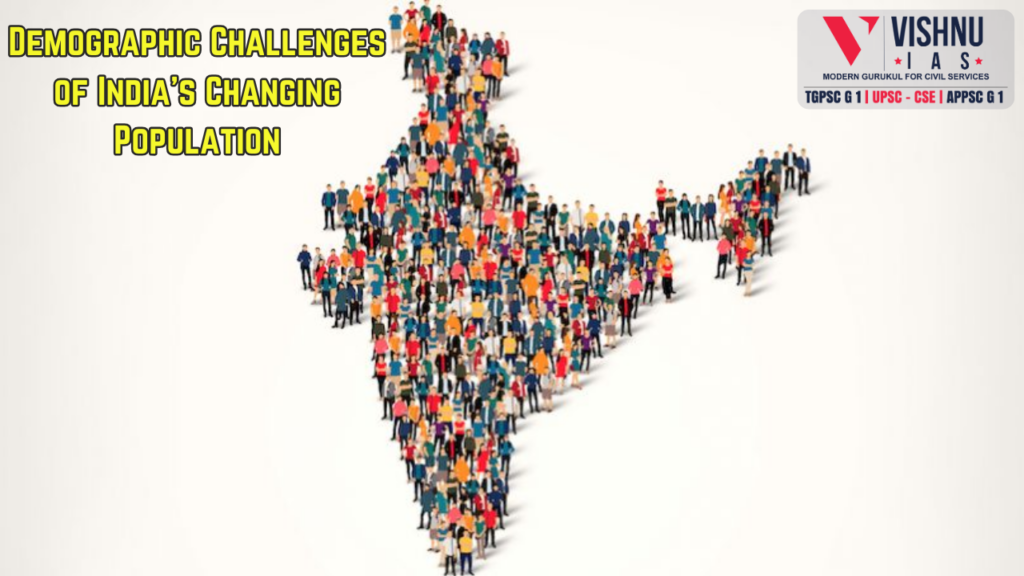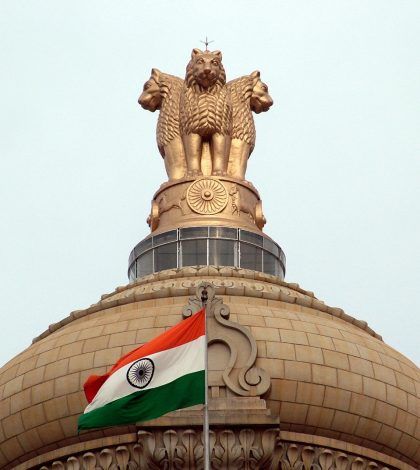Demographic Changes in India
Approach
- Introduction: add few introductory lines about the demography of India’s changing population
- Body: add the comprehensive analysis about the demographic challenges of India’s changing population dynamics in the next 50 years
- Conclusion: add its relevance in upcoming days
INTRODUCTION
India’s population dynamics are set to undergo significant changes over the next 50 years, presenting a range of demographic challenges. These challenges include managing a growing population, addressing the needs of an aging population, ensuring adequate employment opportunities, and dealing with urbanization and environmental sustainability.
- Population Growth and Decline
- Peak Population:India’s population is projected to peak at around 1.65 billion by 2061 before beginning to decline. This peak will place immense pressure on resources, infrastructure, and services.
- Declining Fertility Rates:While the overall population will grow, fertility rates are expected to decline, leading to a slower population growth rate. This shift will require adjustments in policies related to family planning and reproductive health.
- Aging Population
- Increasing Elderly Population:The proportion of the elderly population (aged 60 and above) is expected to quadruple, reaching around 316 million by 2061. This demographic shift will necessitate significant changes in healthcare, pension systems, and social support structures.
- Dependency Ratio: An increasing elderly population will raise the dependency ratio, meaning fewer working-age individuals will support more dependents. This could strain public finances and social services.
- Youthful Population and Employment
- Demographic Dividend: India currently has a significant youthful population, with over 40% under the age of 25. This demographic dividend presents an opportunity for economic growth if harnessed effectively.
- Job Creation: To capitalize on this demographic dividend, India will need to create millions of jobs annually. Failure to do so could lead to high unemployment rates, social unrest, and economic stagnation.
- Education and Skills Development:Improving the quality of education and vocational training is crucial to equip the young population with the skills needed for a rapidly changing job market.
- Urbanization
- Rapid Urbanization: India is experiencing rapid urbanization, with a significant portion of the population moving to urban areas in search of better opportunities. This trend will continue, leading to the expansion of cities and the creation of new urban centers.
- Urban Infrastructure:The rapid growth of urban areas will require substantial investments in infrastructure, including housing, transportation, water supply, and sanitation. Managing urban sprawl and ensuring sustainable urban development will be critical challenges.
- 5. Environmental Sustainability
- Resource Management:A growing population will increase the demand for natural resources such as water, energy, and food. Sustainable management of these resources will be essential to prevent shortages and environmental degradation.
- Climate Change:India is highly vulnerable to the impacts of climate change, including extreme weather events, rising sea levels, and changing agricultural patterns. Addressing these challenges will require robust adaptation and mitigation strategies.
- 6. Regional Disparities
- Socioeconomic Inequalities:Significant disparities exist between different regions of India in terms of economic development, healthcare, education, and infrastructure. Bridging these gaps will be crucial to ensure balanced and inclusive growth.
- Migration Patterns:Internal migration from less developed to more developed regions will continue, driven by economic opportunities and environmental factors. Managing this migration and ensuring the integration of migrants into urban areas will be important.
CONCLUSION
India’s changing population dynamics over the next 50 years will present a complex set of challenges. Addressing these challenges will require comprehensive and forward-looking policies that focus on sustainable development, social equity, and economic growth. By effectively managing its demographic transition, India can harness its population’s potential to drive progress and improve the quality of life for all its citizens.
Anthropology Full Course at Vishnu IAS Academy
What does Course Offer?
- 4 Months (250+ Class Hours)
- Online (App + Web) / Offline / Hybrid Mode of Classes
- Live + Recorded Videos Access For 1 Year
- 2 Hour Live Class From Monday to Saturday (1.5 Hours for Class + ½ Hour for Doubt Solving)
- Foundation to Advanced Level of Teaching
- Simple and Integrated Content
- One Stop Solution Books
- Regular Value Added Content
- Current Affairs & Case Studies Modules
- Daily Answer Writing Practice
- Weekly Grand Tests On Sundays & Evaluation With Guidance and Topper Will be Rewarded
- 500+ Model Answers
- 9 AM – 9 PM Support System
- Free GS Current Affairs
- Free Interview Guidance for Anthropology


